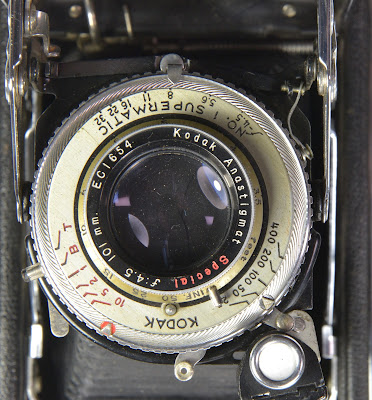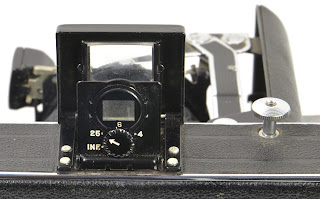Over the years, I have had opportunities to photograph with many different folding cameras, ranging from the simple and inexpensive Ansco Speedex, to various flavors of Zeiss Ikon Ikontas, and many in between. The Kodak Tourist was a widely used 6x9 folder, and are relatively inexpensive on today’s market. However, the one thing hampering many of the Kodak models is the creation of 620 film - really, just 120 film on a smaller diameter spool. That one quirk has a lot of people not wanting to shoot with some of the nicer 620 cameras bearing the Kodak label. Instead, they look to European Agfas, Voigtlanders, Baldas, and Zeiss Ikontas to load with 120 film, and I can’t blame them. However, the Kodak Vigilant SIX-20 - the best one with the Kodak Anastigmat Special 101mm f/4.5 lens, is a wonderful folding camera, produced from 1939-1948. It features the Kodak Supermatic shutter with B, T, 1-1/400 sec shutter speeds, and an aperture range of f/4.5-32, and scale focus from 3 feet to infinity. One of these camera recently came my way - and upon inspection, I realized that it had a roll of film inside, at frame 1. I inadvertently fired the shutter after I extended the bellows, so then I had 6 exposures left, as you get 8 on a roll of 6x9 cm negs.
I decided to shoot the rest of the roll on some good subjects, so I took the camera down to the Ledges Whitewater Park on the French Broad River, just outside of Asheville. I decided to rate the film as ISO 50, as I had no idea how old the film was, but I assumed it was at least 50 years old. I have had a lot of experience with old Verichrome Pan, and knew that I ought to get SOMETHING out of it. So, in the conditions that I had, I ended up shooting at either 1/50 or 1/100 sec, at an appropriate aperture for the conditions - often at F/8.
After I got home, I loaded the film into a Paterson tank, and developed it with the FPP D-96 for 8 min at 20°C, followed by a water rinse and fixing, and then final rinses. When I hung up the film to dry, I was really impressed that this film and camera came through with excellent results. I did not see any problems with pinholes in the bellows, either, but I will do a check on that later.
 |
| perfectly developed with D-96 |
 |
| I love seeing the film info on the leader |
Aside from wanting to test simple cameras like I did for the medium-format toy camera issue no. 3 for Monochrome Mania (out of print now), I didn’t really want to have to re-spool 120 to 620 spools. For most of the Kodaks, it’s just not worth it, but with a few exceptions, and this Vigilant SIX-20 is definitely an exception. I’ll have to re-spool some Kentmere 400 onto 620 so that I can test this camera further.
 |
| That nice lens and shutter combo |
 |
| the viewfinder with parallax adjustment |
The design of this camera is quite nice — and a feature that I have not mentioned is the reverse Galilean viewfinder on the top deck. It has a small adjustment for parallax correction, and there is also one of those small reflex viewers at the front of the bellows, which I hate. Anyhow, I want to shoot with this camera some more. For one, it’s probably the lightest 6x9 camera that anyone can carry in their bag, and it also easily fits into a coat pocket. Unfolded, it’s still fairly compact, and also easy to use. The only thing that might be a problem is figuring out the distance to the subject, as there is no rangefinder, so one of those old accessory rangefinders might be a good idea to carry with me.
There are other versions of this camera, but none of the others have all the bells and whistles of this one. That f/4.5 maximum aperture is far better than the others with a maximum aperture of f/6.3 or f/8.8. The Vigilant isn’t the only camera in this class that can take excellent 6x9 cm images, though. You could look for a Kodak Monitor SIX-20, and all 4 variants of that camera have a lens with a maximum aperture of f/4.5. There’s also the Kodak Special SIX-20 and the Kodak Senior SIX-20 - all take 6x9 cm negatives on 620 film, if you haven’t already figured out the SIX-20.
However, if you are looking for a camera that takes 120 film and makes 6x9 cm negatives, I’d look for a Zeiss Ikonta or a Voigtlander Bessa. A folding camera makes a lot of sense for travel, and these folders will give you nice big negatives. I found that a 3200 dpi scan of one 6x9 negative can produce a 2x3 ft print at 300 DPI. Not too shabby. So, be prepared to re-spool the 120 film onto 620 spools if you want to go the Kodak route. If your camera has a sound bellows, clean lens, and accurate shutter, it will be worth the effort for these big negatives.







1 comment:
This is encouraging, your results are fantastic!. I recently purchased a Kodak Jr. Six-20 III (1937-38) that still has a roll of Verichrome (Pan?) film in it. The film count was on #3 in the red window. I snapped the shutter several times to test the shutter so that frame is trashed (others passing through the antique store may have also). I will shoot the rest at iso 50 as you did. The billows are marginal on the top so I sealed the the iffy areas with Plasti Dip using an artists brush so it looks factory. I still don't trust it until I can fully light test the billows without film. Because of this, I cut the front of a black sock off and put remaining tube over the billows and under the drawbridge for now. The underside of the billows look fine. The lens is only a F6.3 but shooting at F8 or F11 negates it's disadvantage over a F4.5. Well done article! I will eventually post the results on my Instagram: @photobug1971
Post a Comment